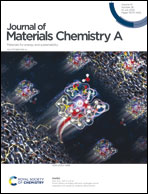Scalable preparation of a CuO nanosheet array via corrosion engineering for selective C–C coupling in CO2 electroreduction†
Abstract
So far, copper (Cu) has been the only monometallic catalyst with substantial selectivity and productivity for the electrochemical CO2 reduction reaction (ECO2RR) to produce C2+ products. However, there still remains an enormous challenge to prepare highly efficient Cu electrodes on a large scale for industrial application. Additionally, further understanding of the structure–activity relationship of electrodes used in the ECO2RR is significantly important but lacking for the design of efficient Cu electrodes. Herein, we report a scalable preparation of a CuO nanosheet array on a Cu substrate via a facile corrosion engineering strategy. By tuning the surface roughness via controlling the corrosion time, we achieved a high faradaic efficiency (FE) for C2+ products (63.93% in an H-type cell, 70% in a flow cell) in the ECO2RR. In addition, the electrode showed a high selectivity exceeding 80% for C2+ products toward the electrochemical CO reduction reaction (ECORR). Moreover, we elucidate the structure–activity relationship of the CO2RR electrodes using our electrodes as a model, where both high active site density and moderate surface roughness are required simultaneously for an efficient CO2RR electrode, which would inspire future related studies.



 Please wait while we load your content...
Please wait while we load your content...